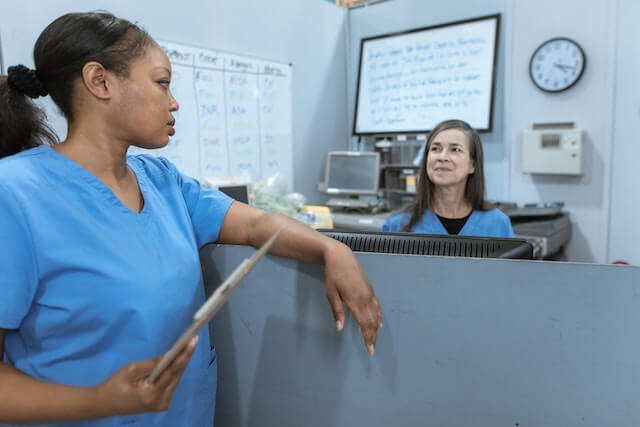Learning how to work as a medical scribe in collaboration with other healthcare professionals requires the desire to overcome a lot of obstacles. Here’s what to expect.
The hospital can be a very loud and busy setting for anyone. Imagine several healthcare workers speed walking across the halls while giving updates on their latest case, phone lines buzzing for a consult request, and the constant echo of a nearby code alert from the PA system above; it’s almost impossible to believe all the communication efforts taking place in that same hospital.
Amidst all of the bright fluorescent lights, the ceaseless beeping of blood pressure monitors, and the constant sounds of keyboards being punched in warp speed, there is a system of communication established that has stood the test of time even in the most imposing of settings.
How to Work as a Medical Scribe in Collaboration with Other Healthcare Professionals
In the middle of collaboration, medical scribes may play a larger role in communicating with various healthcare personnel than one might believe.
Medical scribes often function as an appendage to the physician by tracking a patient even before the physician toggles their name next to the case all the way to ensuring the room the patient was discharged in is clean and prepared for the next one. It’s no surprise that the medical scribe may also be involved in the various avenues of communication for the physician as well.
A Day in the Life of a Medical Scribe
Taking a deeper look into the collaboration medical scribes have with other healthcare personnel, we must first begin looking into the day in the life of a medical scribe with a single patient.
When a patient walks into the hospital, the medical scribe may work with the front desk to assist with guiding the patient to the appropriate area, as well as collaborating with registration to ensure the patient is accurately entered into the EHR system. From there, the medical scribe may also collaborate with the front desk nurse to document and track the triage efforts, while advising their provider of the patient’s arrival and determined acuity.
While the patient is registering, you may also find the medical scribe working with the environmentalist to ensure the designated room is appropriately sanitized and prepared for the patient to be moved. Additionally, depending on whether the patient is able to ambulate or not, the medical scribe may notify the need for a transporter to bring in a wheelchair to assist the patient. All these steps require a degree of documentation, and the medical scribe is there to communicate and capture all pertinent events.
If that seems like a lot, that’s really only the beginning. During the planning and treatment phase of the visit, the medical scribe may also encounter dialogues between team coordinators, radiologists, consulting physicians, nurses, mid-levels, and many other healthcare professionals to ensure the highest quality of patient care is provided.
The Costs of Poor Communication in Healthcare
Medical safety experts at CRICO Strategies investigated 23,000 medical malpractice lawsuits and found more than 7,000 of those lawsuits could be attributed to communication failures. Those communication failures resulted in $1.7 billion in malpractice costs and almost 2,000 preventable deaths. A study conducted by the Joint Commission found that 80% of serious medical errors were the result of miscommunication between caregivers during patient handovers.
Medical scribes play an integral role in the healthcare field by augmenting the communicative efforts, establishing themselves as another check-point in receiving information, and ultimately, decreasing the burden of the physician, allowing for fewer medical errors.

